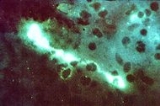
Chlamydophila psittaci
Overview
Chlamydophila psittaci is a lethal intracellular
bacteria
l species that may cause endemic avian
chlamydiosis, epizootic
outbreak
s in mammal
s, and respiratory psittacosis
in humans. Chlamydophila psittaci is transmitted by inhalation, contact or ingestion among birds and to mammals. Psittacosis in birds and in humans often starts with flu-like symptoms and becomes a life-threatening pneumonia
. Many strains remain quiescent
in birds until activated under stress.
Intracellular
Not to be confused with intercellular, meaning "between cells".In cell biology, molecular biology and related fields, the word intracellular means "inside the cell".It is used in contrast to extracellular...
bacteria
Bacteria
Bacteria are a large domain of prokaryotic microorganisms. Typically a few micrometres in length, bacteria have a wide range of shapes, ranging from spheres to rods and spirals...
l species that may cause endemic avian
Bird
Birds are feathered, winged, bipedal, endothermic , egg-laying, vertebrate animals. Around 10,000 living species and 188 families makes them the most speciose class of tetrapod vertebrates. They inhabit ecosystems across the globe, from the Arctic to the Antarctic. Extant birds range in size from...
chlamydiosis, epizootic
Epizootic
In epizoology, an epizootic is a disease that appears as new cases in a given animal population, during a given period, at a rate that substantially exceeds what is "expected" based on recent experience . Epidemic is the analogous term applied to human populations...
outbreak
Outbreak
Outbreak is a term used in epidemiology to describe an occurrence of disease greater than would otherwise be expected at a particular time and place. It may affect a small and localized group or impact upon thousands of people across an entire continent. Two linked cases of a rare infectious...
s in mammal
Mammal
Mammals are members of a class of air-breathing vertebrate animals characterised by the possession of endothermy, hair, three middle ear bones, and mammary glands functional in mothers with young...
s, and respiratory psittacosis
Psittacosis
In medicine , psittacosis — also known as parrot disease, parrot fever, and ornithosis — is a zoonotic infectious disease caused by a bacterium called Chlamydophila psittaci and contracted from parrots, such as macaws, cockatiels and budgerigars, and pigeons, sparrows, ducks, hens, gulls and many...
in humans. Chlamydophila psittaci is transmitted by inhalation, contact or ingestion among birds and to mammals. Psittacosis in birds and in humans often starts with flu-like symptoms and becomes a life-threatening pneumonia
Pneumonia
Pneumonia is an inflammatory condition of the lung—especially affecting the microscopic air sacs —associated with fever, chest symptoms, and a lack of air space on a chest X-ray. Pneumonia is typically caused by an infection but there are a number of other causes...
. Many strains remain quiescent
Virus latency
Virus latency is the ability of a pathogenic virus to lie dormant within a cell, denoted as the lysogenic part of the viral life cycle. A latent viral infection is a type of persistent viral infection which is distinguished from a chronic viral infection...
in birds until activated under stress.

